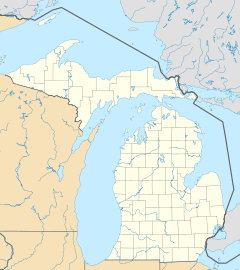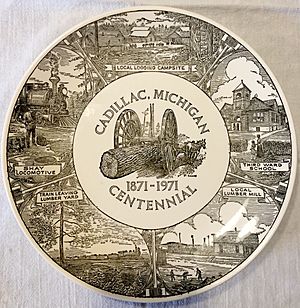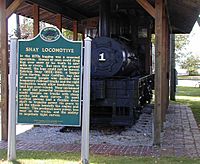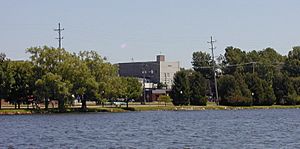Cadillac, Michigan facts for kids
Quick facts for kids
Cadillac, Michigan
|
|
|---|---|
| City of Cadillac | |

Former Cadillac City Hall
|
|
| Nicknames:
Tree City USA, City on the Lakes
|
|

Location within Wexford County
|
|
| Country | United States |
| State | Michigan |
| County | Wexford |
| Settled | 1871 |
| Platted | 1872 |
| Incorporated | 1875 (Clam Lake village) 1877 (city of Cadillac) |
| Government | |
| • Type | Council–manager |
| Area | |
| • Total | 8.91 sq mi (23.09 km2) |
| • Land | 7.05 sq mi (18.27 km2) |
| • Water | 1.86 sq mi (4.82 km2) |
| Elevation | 1,309 ft (399 m) |
| Population
(2010)
|
|
| • Total | 10,355 |
| • Estimate
(2019)
|
10,497 |
| • Density | 1,487.88/sq mi (574.45/km2) |
| Time zone | UTC−5 (Eastern (EST)) |
| • Summer (DST) | UTC−4 (EDT) |
| ZIP code(s) |
49601
|
| Area code(s) | 231 |
| FIPS code | 26-12320 |
| GNIS feature ID | 1619393 |
Cadillac ( kadd-EH-lack) is a city in the U.S. state of Michigan. The city is the county seat of Wexford County. The population was 10,355 at the 2010 census.
Cadillac was settled as early as 1871 and formerly known as the village of Clam Lake before incorporating as a city in 1877. The city is the junction of several major highways, including U.S. Route 131, M-55, and M-115. The geographic center of Michigan is approximately five miles (8.0 km) north-northwest of Cadillac. Cadillac is the central city of the Cadillac micropolitan area, which includes all of Wexford County and Missaukee County to the east, and had population of 48,725 at the 2020 census.
Contents
History
Village of Clam Lake
Although European explorers and traders visited the area since the 18th century, permanent white communities were not established until some time later. Initial settlements were connected with the logging industry.
In 1871, Cadillac's first sawmill began operations. Originally called the Pioneer Mill, it was built by John R. Yale. That same year, George A. Mitchell, a prominent Cadillac banker and railroad entrepreneur, and Adam Gallinger, a local carpenter, formed the Clam Lake Canal Improvement and Construction Company. Two years later, the Clam Lake Canal was constructed between Big and Little Clam lakes, present-day Lakes Mitchell and Cadillac. Sawmill owners used the canal to transport timber from Big Clam Lake to the mills and railroad sites—the G.R. & I. Railroad had reached the area in 1872—on Little Clam Lake, in Cadillac.
Cadillac was originally named Clam Lake and was incorporated as a village in 1874. George Mitchell was elected the first mayor. The village was incorporated as a city in 1877 and renamed Cadillac, after Antoine Laumet de La Mothe, sieur de Cadillac, a Frenchman who made the first permanent settlement at Detroit in 1701.
Battle of Manton
The Wexford County seat of government, originally located in Sherman, was moved to Manton in 1881, as the result of a compromise between the feuding residents of Cadillac and Sherman. Cadillac partisans, however, won the county seat by county-wide vote in April 1882. The day following the election a sheriff's posse left the city for Manton by special train to seize the county records. After arriving and collecting a portion of the materials, however, an angry crowd confronted the Cadillac men and drove them from the town.
When the sheriff returned to Cadillac, a force consisting of several hundred armed men was assembled; this group reportedly included a brass band. The Sheriff's force, some of whom may have been intoxicated, traveled back to Manton to seize the remaining records. Although Manton residents confronted the Cadillac men and barricaded the courthouse, the posse successfully seized the documents and, in dubious glory, returned to Cadillac.
City of Cadillac
In 1878, Ephraim Shay perfected his Shay locomotive, which was particularly effective in its ability to climb steep grades, maneuver sharp turns and manage imperfections in railroad tracks. Cadillac was home to the Michigan Iron Works Company, which manufactured the Shay locomotive for a short time in the early 1880s. It was however the lumber industry that continued to dominate the city, drawing in a large immigrant labor force, most of whom were Swedish (two of Cadillac's sister cities are Mölnlycke, Sweden, and Rovaniemi, Finland).
In 1899, the Cadillac Club formed, the forerunner of the Cadillac Area Chamber of Commerce. Gradually, various manufacturing firms found success in Cadillac. Cadillac's range of industries includes the manufacture of pleasure boats, automotive parts, water-well components, vacuum cleaners, and rubber products.
In 1936, the U.S. Forest Service and the Civilian Conservation Corps created the Caberfae Ski Area, which led to promotion of the area as a tourist center. Caberfae remains in operation today, as the oldest ski resort in the midwest. Tourism has since become an important sector of Cadillac's economy. In the summer, tourists travel to the city for boating, fishing, hiking, mountain biking and camping. During the fall, hunting and color tours are popular. The winter is possibly the busiest season; the area can be found packed with downhill skiers, cross-country skiers, ice-fishers, snow-shoers and–most of all-snowmobilers. The North American Snowmobile Festival (NASF) is held on frozen Lake Cadillac every winter.
Thirsty's, a gas station on M-55 west of Cadillac, was the home of Samantha or "Sam The Bear" from the 1970s through the late 1990s, when Sam died of old age.
In October 1975 the rock group Kiss visited Cadillac and performed at the Cadillac High School gymnasium. They played the concert to honor the Cadillac High School football team. In previous years, the team had compiled a record of sixteen consecutive victories, but the 1974 squad opened the season with two losses. The assistant coach, Jim Neff, an English teacher and rock'n'roll fan, thought to inspire the team by playing Kiss music in the locker room. He also connected the team's game plan, K-I-S-S or "Keep It Simple Stupid", with the band. The team went on to win seven straight games and their conference co-championship. After learning of their association with the team's success, the band decided to visit the school and play for the homecoming game.
Historic landmarks
Cadillac maintains a number of state historic landmarks. Most are marked with a green "Michigan Historical Marker" sign that includes a description of the landmark. There are six markers within the city limits: 'Cadillac Carnegie Library,' 'Charles T. Mitchell House,' 'Clam Lake Canal,' 'Cobbs & Mitchell Building,' 'Cobbs & Mitchell No. 1' and the 'Shay Locomotive,' which is pictured at the right. Two more are in the near Cadillac area ('Caberfae Ski Resort' and 'Greenwood Disciples of Christ Church') and another two are dispersed in surrounding Wexford County ('Battle of Manton' and '1st Wexford County Court House').
Geography
Topography
According to the United States Census Bureau, the city has a total area of 9.02 square miles (23.36 km2), of which 7.16 square miles (18.54 km2) is land and 1.86 square miles (4.82 km2) is water.
The 1,150-acre (5 km2) Lake Cadillac is entirely within the city limits. The larger, 2,580-acre (10 km2) Lake Mitchell is nearby on the west side of the city, with 1,760 feet (540 m) of shoreline within the city's municipal boundary. The lakes were connected by a stream which was replaced in 1873 by the Clam Lake Canal. The canal was featured on Ripley's Believe It or Not in the 1970s due to the phenomenon that in winter the canal freezes before the lakes and then after the lakes freeze, the canal thaws and remains unfrozen for the rest of the winter.
Cadillac sits on the eastern edge of the Manistee National Forest and the surrounding area is heavily wooded with mixed hardwood and conifer forests. A main agricultural industry in the area is Christmas tree farming. Cadillac was chosen in 1988 to donate the holiday tree to sit on the lawn of the U.S. Capitol building in Washington D.C.
The area surrounding Cadillac is primarily rural, and is considered to be part of Northern Michigan. The small size of nearby communities make the city a major commercial and industrial hub of the region.
 |
Mesick, Michigan | Manton, Michigan | Lake City, Michigan |  |
| Wellston, Michigan | McBain, Michigan | |||
| Tustin, Michigan | Marion, Michigan |
Cityscape
The commercial center of the city is located on the eastern edge of Lake Cadillac. Most downtown buildings range from two to five stories in height and face the traditional corridor of travel through town, Mitchell Street, the city's tree-lined main street. The downtown contains a movie theater, gift shops, restaurants, a bookstore, specialty food stores, jewelers, clothing retailers and various other businesses. The Courthouse Hill Historic District, established in April 2005, lies adjacent to the city's commercial center. The District contains a number of large Victorian-style residences built by the lumber barons and businessmen who helped establish the city in the 1870s. Population and building density is highest in this area.
On the western portion of Lake Cadillac, where M-55 intersects M-115, is what is locally referred to as Cadillac West. This is a small commercial district, bordering Mitchell State Park and the two lakes, which caters mostly to tourists. It contains a number of motels and restaurants.
Along the northern and southern stretches of the lake are the residential areas of the city. They are generally of low to moderate density, characterized primarily by single family structures.
Climate
Cadillac experiences a typical northern Michigan climate, undergoing temperate seasonal changes, influenced by the presence of Lake Michigan and the inevitable lake effect. Winters are generally cold with large amounts of snowfall. Summers are warm. The average high temperature in July is 80 °F (27 °C) and the average low is in February, at 9 °F (−13 °C). Summer temperatures can exceed 90 °F (32 °C), and winter temperatures can drop below 0 °F (−18 °C). Average annual rainfall is 30 inches (76 cm), and average annual snowfall is 81 inches (206 cm) . Snowfall typically occurs between the months of November and March. According to the Köppen Climate Classification system, Cadillac has a humid continental climate, abbreviated "Dfb" on climate maps.
| Climate data for Cadillac Michigan | |||||||||||||
|---|---|---|---|---|---|---|---|---|---|---|---|---|---|
| Month | Jan | Feb | Mar | Apr | May | Jun | Jul | Aug | Sep | Oct | Nov | Dec | Year |
| Average high °F (°C) | 26 (−3) |
27 (−3) |
36 (2) |
52 (11) |
65 (18) |
75 (24) |
80 (27) |
78 (26) |
69 (21) |
57 (14) |
41 (5) |
30 (−1) |
53 (12) |
| Average low °F (°C) | 11 (−12) |
9 (−13) |
18 (−8) |
30 (−1) |
41 (5) |
52 (11) |
56 (13) |
54 (12) |
48 (9) |
38 (3) |
27 (−3) |
17 (−8) |
33 (1) |
| Average precipitation inches (mm) | 1.7 (43) |
1.6 (41) |
1.9 (48) |
2.7 (69) |
3.0 (76) |
3.1 (79) |
2.9 (74) |
2.9 (74) |
3.5 (89) |
2.8 (71) |
2.7 (69) |
1.7 (43) |
30.4 (770) |
| Source: Weatherbase | |||||||||||||
Superfund sites
Cadillac is also home to two superfund sites according to the U.S. Environmental Protection Agency. One located at 1100 Wright Street, the former home of Kysor Industrial Corp. The other is located at 1002 6th Street, the former home of Northernaire Plating.
Demographics
| Historical population | |||
|---|---|---|---|
| Census | Pop. | %± | |
| 1880 | 2,213 | — | |
| 1890 | 4,461 | 101.6% | |
| 1900 | 5,997 | 34.4% | |
| 1910 | 8,375 | 39.7% | |
| 1920 | 9,750 | 16.4% | |
| 1930 | 9,570 | −1.8% | |
| 1940 | 9,855 | 3.0% | |
| 1950 | 10,425 | 5.8% | |
| 1960 | 10,112 | −3.0% | |
| 1970 | 9,990 | −1.2% | |
| 1980 | 10,199 | 2.1% | |
| 1990 | 10,104 | −0.9% | |
| 2000 | 10,000 | −1.0% | |
| 2010 | 10,355 | 3.6% | |
| 2019 (est.) | 10,497 | 1.4% | |
| U.S. Decennial Census | |||
2010 census
As of the census of 2010, there were 10,355 people, 4,280 households, and 2,625 families residing in the city. The population density was 1,446.2 inhabitants per square mile (558.4/km2). There were 4,927 housing units at an average density of 688.1 per square mile (265.7/km2). The racial makeup of the city was 95.6% White, 0.5% African American, 0.6% Native American, 1.0% Asian, 0.4% from other races, and 1.8% from two or more races. Hispanic or Latino of any race were 1.8% of the population.
There were 4,280 households, of which 32.9% had children under the age of 18 living with them, 39.2% were married couples living together, 16.4% had a female householder with no husband present, 5.7% had a male householder with no wife present, and 38.7% were non-families. 32.0% of all households were made up of individuals, and 14% had someone living alone who was 65 years of age or older. The average household size was 2.34 and the average family size was 2.90.
The median age in the city was 36.5 years. 24.7% of residents were under the age of 18; 10% were between the ages of 18 and 24; 24.4% were from 25 to 44; 23.8% were from 45 to 64; and 17.1% were 65 years of age or older. The gender makeup of the city was 47.4% male and 52.6% female.
Lou Gehrig's Disease
Based on a single, limited study involving twenty people, some people have labeled Cadillac as one of three "hot spots" for Lou Gehrig's Disease in the US. However, the study made no attempt to ascertain the occurrence of the disease in other parts of the state, or elsewhere in the country. The study was designed to examine the possible occurrence of the disease due to genetic influences. The occurrence of the disease within the city limits of Cadillac is reportedly over 100 times the normal rate. The cause of the abnormally large occurrence of the disease in Cadillac remains unknown.
Transportation
Major highways
Cadillac is situated as the confluence of three highways: US 131, M-55 and M-115. Prior to 2001, the northern end of the freeway portion of US 131 was located at the southern entrance to Cadillac. With the construction of a bypass, the US 131 freeway was extended around the east side of the city. The former route of the highway through downtown Cadillac was redesignated as BUS US 131. In the city, BUS US 131 is named Mitchell Street, after George Mitchell, but may be referred to as main street.
 US 131 bypasses the city to the east. The freeway continues southerly toward Big Rapids and Grand Rapids and northerly toward Manton before transitioning to a two-lane highway for the remainder of the distance to Petoskey.
US 131 bypasses the city to the east. The freeway continues southerly toward Big Rapids and Grand Rapids and northerly toward Manton before transitioning to a two-lane highway for the remainder of the distance to Petoskey.


 Bus. US 131, a loop route through downtown, running largely along the former route of US 131 through the city.
Bus. US 131, a loop route through downtown, running largely along the former route of US 131 through the city. M-55 is a major two-lane east–west route across the state, connecting with Manistee on the west and Lake City, Houghton Lake, West Branch, and Tawas City on the east.
M-55 is a major two-lane east–west route across the state, connecting with Manistee on the west and Lake City, Houghton Lake, West Branch, and Tawas City on the east.- M-115, another major two-lane route, runs diagonally from Clare to the southeast to Frankfort to the northwest.
Rail
The city is serviced by rail via the Great Lakes Central Railroad. This is primarily a freight line, although passenger service is expected in the future.
Public transit
- Cadillac and Wexford County jointly operate a local public bus service. The Cadillac/Wexford Transit Authority (CWTA) is a demand-response, public transportation system, and has been in operation since 1974.
- Indian Trails provides daily intercity bus service between Grand Rapids and St. Ignace and stops in Cadillac.
Non-motorized transportation
The White Pine Trail's northern terminus is in Cadillac. The trail, which stretches 92 miles (148 km) and originates from Comstock Park, follows an abandoned railroad bed into the center of the city. The trail is paved from the village of Leroy 16 miles north to Cadillac.
Economy
Manufacturing has been the greatest employer in Cadillac since the logging industry. More than 26% of the city's labor force is employed in manufacturing. Three industrial parks are located within the city limits, comprising 7% of the total land use in Cadillac. Their operations generate 47% of the city's tax base. Much of the city's economic performance is determined by the fortunes of local industry.
The center of the city is generally perceived to have a "small-town-feel". In the summer, the downtown fills with tourists, many from southern Michigan. The city center is one block from Lake Cadillac. For visitors by boat who dock at the public docks, it is nearly as accessible by boat as it is by car. The city's immediate proximity to two lakes, as well as Manistee National Forest, Pere Marquette State Forest, Mitchell State Park and a number of major highways, has established tourism as a significant sector of the local economy.
During the winter months, Lake Cadillac and Lake Mitchell freeze over and the city becomes covered with snow. Cadillac is connected to a number of trail systems popular with winter recreation enthusiasts. The city integrates unusually well into the corridors of travel created by snowmobilers.
Cadillac is also known as Chestnut Town, USA. The local area has a relatively high number of American chestnut trees, planted by pioneers from New York and Pennsylvania who settled in western Michigan. A blight in the early 20th century killed nearly every American Chestnut tree, but those in western Michigan had developed a mysterious resistance and survived.
Top employers
According to the city's 2019 Comprehensive Annual Financial Report, the principal employers in the city were:
| Employer | # of employees (2019) |
|---|---|
| Avon Automotive | 500–999 |
| Cadillac Area Public Schools | 500–999 |
| Four Winn's/Glastron/Wellcraft/Rec Boat | 500–999 |
| Avon Protection Systems | 250–499 |
| Cadillac Casting | 250–499 |
| Munson Healthcare Cadillac Hospital | 250–499 |
| Rexair | 250–499 |
| AAR Mobility Systems | 100–249 |
| Michigan Rubber Products | 100–249 |
| Fiamm Technologies | 100–249 |
Education
Cadillac's public education system has a total of 10 schools, with approximately 3,100 students and 166 teachers with a student:teacher ratio of 19.1:1. Cadillac has 4 private primary and secondary schools with approximately 394 students, 20 teachers and a student:teacher ratio of 20:1.
Cadillac Area Public Schools (CAPS)
The city has two high schools: Cadillac High School and Innovation High School. The area also has a junior high school, covering grades 7 and 8, located adjacent to the high school, and a middle school, Mackinaw Trail Middle School, covering grades 5 and 6. There are four elementary schools, Forest View Elementary, Franklin Elementary, Kenwood Elementary, and Lincoln Elementary.
Cadillac also has an alternative high school, located in the building that formerly housed Cooley Elementary School. Adult high school and GED courses are offered there as well. As a whole, the programs at Cooley are part of a curriculum that aids individuals in overcoming the exceptional obstacles to their educational and workforce goals.
Vocational career training is available to high school students free of charge in Cadillac and nearby schools at Wexford-Missaukee Independent School District (ISD) Career Tech Center (formerly Wexford-Missaukee Vocational Center or Voc-Tech). Students are bussed for part of the day to the Career Tech Center from their respective schools and receive credits toward high school graduation. Students are also able to earn certification in a chosen trade. Courses include:
- Agriscience
- Allied Heath Technologies
- Automotive
- Building Trades
- Business Management and Administration
- Computers and Electronics
- Digital Media Productions
- Electrical Occupations (formally Robotics and Automation)
- Heavy Equipment
- Hospitality Retailing and Entrepreneureship
- Machine Trades
- Metal Fabrication
- Power sports and Equipment
Cosmetology is offered through the Career Tech Center, but at an off-campus location in downtown Cadillac. Adults can attend the vocational or cosmetology school with tuition or financial aid for certification.
Cadillac hosts the Wexford-Missaukee ISD Special Education for residents of the two counties who are in need of special services. This school is on the same campus as the Career Tech Center.
The class of 2006 was the largest class to go through Cadillac Public Schools.
Private schools
Cadillac offers several options for private religious education.
Cadillac Heritage Christian offers nondenominational Christian education from pre-K through 12th grade. It is a coed school with 98 students and a teacher:student ratio of 1:11. Graduating classes are typically between 3–12 students.
Northview Adventist School has 16 students in grades 1–10 as of 2020. It is a coed Seventh Day Adventist School. They operate in a one-room format, with one teacher that doubles as the principal, and one or two teachers assistants. They also have a multitude of volunteers that runs a library, band, and physical education, among other things. They do not participate in competitive sports.
Noah's Ark Day School is a small alternative non-denominational Christian school for students in pre-K through first grade only. It is coed with 42 students and 1 teacher.
Cadillac's largest and most well-known private school is St. Ann School, a coed private Roman Catholic school with 236 students in grades pre-K through 7. The teacher:student ratio is 1:26. St. Ann is a member of the National Catholic Education Association. No Catholic high school education is offered at St. Ann School, and students typically attend public school for grades 8–12.
Training schools
Northwoods Aviation, located at Wexford County Airport, offers training programs for piloting and servicing aircraft. Northwoods Aviation also offers primary instruction for those interested in sport pilot, private, and commercial certificates.
The Cadillac Institute of Cosmetology (formerly Cadillac Academy of Beauty) is a full service teaching salon in downtown Cadillac that offers training for general cosmetologists and specialized technicians to high school students through a partnership with Wexford-Missaukee Intermediate School District. Training is also available to adult students though private courses on a tuition basis. Upon completion of the program, students are qualified to take the state board exam to become a licensed cosmetologist or specialty technician.
Colleges
The Baker College-Cadillac campus occupies 66 acres (270,000 m2) just outside the City of Cadillac. The school has an enrollment of more than 1,300 students and offers Associate's and bachelor's degrees, in addition to professional certifications.
Notable people
- Jim Bowman, NFL player
- Jan Harold Brunvand, American folklorist, born in Cadillac
- Larry Joe Campbell, actor (According to Jim); born in Cadillac
- George A. Mitchell, father of the city of Cadillac (first developer).
- Jackie Swanson, actress (Cheers), attended high school in Cadillac
- Guy Vander Jagt, U.S. congressman from Michigan's 9th congressional district; born in Cadillac
- Luke Winslow-King, musician; born in Cadillac
- Ad Wolgast, professional boxer; born in Cadillac
Images for kids
See also
 In Spanish: Cadillac (Míchigan) para niños
In Spanish: Cadillac (Míchigan) para niños











